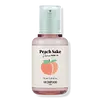What's inside
What's inside
 Key Ingredients
Key Ingredients

 Benefits
Benefits

 Concerns
Concerns

 Ingredients Side-by-side
Ingredients Side-by-side

Water
Skin ConditioningSilica
AbrasivePhenyl Trimethicone
Skin ConditioningCetyl Ethylhexanoate
EmollientIsohexadecane
EmollientPolymethyl Methacrylate
Hydrogenated Polyisobutene
EmollientDimethicone
EmollientPrunus Persica Fruit Extract
AbrasiveRice Ferment Filtrate
Skin ConditioningPolyglyceryl-3 Methylglucose Distearate
EmulsifyingSorbitan Stearate
EmulsifyingAlcohol Denat.
AntimicrobialButylene Glycol
HumectantSynthetic Fluorphlogopite
Cetearyl Alcohol
EmollientPropylene Glycol
HumectantCI 77891
Cosmetic ColorantCarbomer
Emulsion StabilisingTriethanolamine
BufferingSucrose Cocoate
EmulsifyingTocopheryl Acetate
AntioxidantMagnesium Aluminum Silicate
AbsorbentArgania Spinosa Kernel Oil
EmollientHydrogenated Lecithin
EmulsifyingEnantia Chlorantha Bark Extract
Skin ConditioningDisodium EDTA
Sesamum Indicum Seed Oil
EmollientStearyl Glycyrrhetinate
Skin ConditioningBeta-Sitosterol
Emulsion StabilisingSerenoa Serrulata Fruit Extract
Skin ConditioningGlycyrrhiza Glabra Root Extract
BleachingCentella Asiatica Extract
CleansingTocopherol
AntioxidantGlycine Soja Seed Extract
Skin ConditioningOleanolic Acid
Skin ConditioningChamomilla Recutita Flower Extract
MaskingPhenoxyethanol
PreservativeCeramide AP
Skin Conditioning1,2-Hexanediol
Skin ConditioningCI 17200
Cosmetic ColorantCI 19140
Cosmetic ColorantCI 15985
Cosmetic ColorantParfum
MaskingWater, Silica, Phenyl Trimethicone, Cetyl Ethylhexanoate, Isohexadecane, Polymethyl Methacrylate, Hydrogenated Polyisobutene, Dimethicone, Prunus Persica Fruit Extract, Rice Ferment Filtrate, Polyglyceryl-3 Methylglucose Distearate, Sorbitan Stearate, Alcohol Denat., Butylene Glycol, Synthetic Fluorphlogopite, Cetearyl Alcohol, Propylene Glycol, CI 77891, Carbomer, Triethanolamine, Sucrose Cocoate, Tocopheryl Acetate, Magnesium Aluminum Silicate, Argania Spinosa Kernel Oil, Hydrogenated Lecithin, Enantia Chlorantha Bark Extract, Disodium EDTA, Sesamum Indicum Seed Oil, Stearyl Glycyrrhetinate, Beta-Sitosterol, Serenoa Serrulata Fruit Extract, Glycyrrhiza Glabra Root Extract, Centella Asiatica Extract, Tocopherol, Glycine Soja Seed Extract, Oleanolic Acid, Chamomilla Recutita Flower Extract, Phenoxyethanol, Ceramide AP, 1,2-Hexanediol, CI 17200, CI 19140, CI 15985, Parfum
Water
Skin ConditioningGlycerin
HumectantButylene Glycol
HumectantSodium Styrene/Acrylates Copolymer
Methyl Gluceth-10
EmulsifyingMaltitol
HumectantGlutamic Acid
HumectantArbutin
AntioxidantLeucine
Skin ConditioningGlycine Soja Protein
EmulsifyingCeramide NP
Skin ConditioningArginine
MaskingPlacental Protein
HumectantDipotassium Glycyrrhizate
HumectantCeramide AP
Skin ConditioningHydroxyethylcellulose
Emulsion StabilisingPEG-60 Hydrogenated Castor Oil
EmulsifyingSodium Citrate
BufferingCitric Acid
BufferingPhenoxyethanol
PreservativeMethylparaben
PreservativeRice Ferment Filtrate
Skin ConditioningParfum
MaskingWater, Glycerin, Butylene Glycol, Sodium Styrene/Acrylates Copolymer, Methyl Gluceth-10, Maltitol, Glutamic Acid, Arbutin, Leucine, Glycine Soja Protein, Ceramide NP, Arginine, Placental Protein, Dipotassium Glycyrrhizate, Ceramide AP, Hydroxyethylcellulose, PEG-60 Hydrogenated Castor Oil, Sodium Citrate, Citric Acid, Phenoxyethanol, Methylparaben, Rice Ferment Filtrate, Parfum
 Reviews
Reviews

Ingredients Explained
These ingredients are found in both products.
Ingredients higher up in an ingredient list are typically present in a larger amount.
Butylene Glycol (or BG) is used within cosmetic products for a few different reasons:
Overall, Butylene Glycol is a safe and well-rounded ingredient that works well with other ingredients.
Though this ingredient works well with most skin types, some people with sensitive skin may experience a reaction such as allergic rashes, closed comedones, or itchiness.
Learn more about Butylene GlycolCeramide AP is formally known as Ceramide 6.
Ceramides are intercellular lipids naturally found in our skin that bonds dead skin cells together to create a barrier. Having a strong skin barrier leads to more firm and hydrated skin.
They are known for their ability to hold water and thus are a great ingredient for dry skin. By bolstering the skin ceramides act as a barrier against irritating ingredients. This can help with inflammation as well.
If you would like to eat ceramides, sweet potatoes contain a small amount.
Read more about other common types of ceramides here:
Ceramide NP
Ceramide EOP
Parfum is a catch-all term for an ingredient or more that is used to give a scent to products.
Also called "fragrance", this ingredient can be a blend of hundreds of chemicals or plant oils. This means every product with "fragrance" or "parfum" in the ingredients list is a different mixture.
For instance, Habanolide is a proprietary trade name for a specific aroma chemical. When used as a fragrance ingredient in cosmetics, most aroma chemicals fall under the broad labeling category of “FRAGRANCE” or “PARFUM” according to EU and US regulations.
The term 'parfum' or 'fragrance' is not regulated in many countries. In many cases, it is up to the brand to define this term.
For instance, many brands choose to label themselves as "fragrance-free" because they are not using synthetic fragrances. However, their products may still contain ingredients such as essential oils that are considered a fragrance by INCI standards.
One example is Calendula flower extract. Calendula is an essential oil that still imparts a scent or 'fragrance'.
Depending on the blend, the ingredients in the mixture can cause allergies and sensitivities on the skin. Some ingredients that are known EU allergens include linalool and citronellol.
Parfum can also be used to mask or cover an unpleasant scent.
The bottom line is: not all fragrances/parfum/ingredients are created equally. If you are worried about fragrances, we recommend taking a closer look at an ingredient. And of course, we always recommend speaking with a professional.
Learn more about ParfumPhenoxyethanol is a preservative that has germicide, antimicrobial, and aromatic properties. Studies show that phenoxyethanol can prevent microbial growth. By itself, it has a scent that is similar to that of a rose.
It's often used in formulations along with Caprylyl Glycol to preserve the shelf life of products.
Rice Ferment Filtrate is created by fermenting rice, or oryza sativa. A common name for this ingredient is sake, the traditional Japanese fermented rice alcoholic beverage.
Rice ferment is skin-conditioning and contains anti-aging components.
Rice contains numerous antioxidants which may help with anti-aging, such as vitamin E. Antioxidants help stabilize free-radical molecules. Unstable free-radical molecules may damage your skin cells and accelerate signs of aging.
A study from 2013 found fermented rice water to help decrease sun damage by increasing collagen production.
Learn more about Rice Ferment FiltrateWater. It's the most common cosmetic ingredient of all. You'll usually see it at the top of ingredient lists, meaning that it makes up the largest part of the product.
So why is it so popular? Water most often acts as a solvent - this means that it helps dissolve other ingredients into the formulation.
You'll also recognize water as that liquid we all need to stay alive. If you see this, drink a glass of water. Stay hydrated!
Learn more about Water